
I’m always on the look out for suitable quilts for Siblings Together. Something reasonably straightforward, colourful and preferably using scraps. I came across a quilt which was made for the charity Do. Good. Stitches. If I were cleverer I’d link it but it’s on Flickr and we’ve always had an uneasy relationship…. And then as if to confirm my choice a very similar quilt appeared on the ModaBakingShop.
Both are made up of house blocks but with good use of negative space and different values. The mama for the flickr quilt was The Hoffmeister and I can’t find him or her anywhere! And the designer of the other quilt was Debbie from Esche House. I have at least two of her designs and have yet to make up either. Anyway inspired by these designers this is our quilt block for February.
Now I’d like each Bee member please to make one 4 by 3 block as the above picture made up of a number of houses and 1 or 2 white squares. If you are keen feel free to make more extra single houses which would mean I could add a row.
To make this block the trick is getting a good range of fabric values. They give depth I think. So when choosing your fabric/scraps can I suggest that you lump them into low value, medium value and dark value as I’ve done below. Go for a good mix of colours as well as value
Doing a quick picture edit and making the picture black and white will help as well.
From your three piles choose 2 or 3 low value fabrics, 3 or 4 from each of the medium and dark value piles and then depending how many you’ve selected from these piles then 1 or 2 plain bright white. You need to have 12 squares including the white. That should mix it up nicely and give the block good variety.
So to the houses.
Cut out 5.5” squares of all your chosen fabrics including the white. You should have 12 squares. Set aside the white one(s).
For each coloured square you need a 3.5” by 4.5” white rectangle cut in two for the roof. This should be from the same bright white solid you are using for the 1 or 2 white squares.

Now either finger press or mark with an erasable marker pen the mid point on the top of your square and 1/4” either side.
 Place your white triangle as in the picture below with the shortest side of the white triangle at the bottom. The top being at the 1/4”mark and the bottom corner 2” down one side. Feel free to eye ball this rather than mark. I placed the coloured square and white triangle on my cutting mat as you can see so measuring the 2” was easy. See below
Place your white triangle as in the picture below with the shortest side of the white triangle at the bottom. The top being at the 1/4”mark and the bottom corner 2” down one side. Feel free to eye ball this rather than mark. I placed the coloured square and white triangle on my cutting mat as you can see so measuring the 2” was easy. See below

Now sew the white triangle corner to corner using a scant 1/4” seam so that you can then flip back the white triangle to make half the roof.


Trim corner off and trim block. Now mark the centre again and 1/4”mark from right of centre (or eyeball it). In the picture below you can see how to place the second white triangle. Again 2” down from the top on the left hand side with the top corner just at the 1/4” mark.

Sew corner to corner and flip and press white triangles to make roof. Cut off surplus fabric from behind


Trim back the white so that the square is 5.5” and you’ve got one house. And yes that left hand roof looks as it’s sloping more than the other but a quick check will see it’s an optical illusion because you can see the whole seam

Then once you have all your houses put them into a 4 by 3 block as the picture below mixing in the white plain squares and all the houses in any way pleasing to you.

The finished block should be 20.5” by 15.5”. Mine was wildly out because I made this block when I was getting used to a new machine…… This beautiful Singer Featherweight 66 years young . But I need to master an accurate seam. But the beauty of this block it is easy to trim to size.
 Hope that’s clear but any problems do get back to me.
Hope that’s clear but any problems do get back to me.


 Maths is not a popular subject in my house. None of my children enjoy it and maths teaching is very variable to put it mildly. We were ecstatic if not surprised when no. 1 son passed his maths GCSE but the twins are still going through the grind of learning what they need to to get this qualification . The most common complaint is they can never imagine an occasion in their future when they are going to need to use geometry, solving simultaneous equations, trigonometry etc etc. Well I can now say that in the highly unlikely circumstance of them having to design a medallion quilt then their maths could eventually be of use to them.
Maths is not a popular subject in my house. None of my children enjoy it and maths teaching is very variable to put it mildly. We were ecstatic if not surprised when no. 1 son passed his maths GCSE but the twins are still going through the grind of learning what they need to to get this qualification . The most common complaint is they can never imagine an occasion in their future when they are going to need to use geometry, solving simultaneous equations, trigonometry etc etc. Well I can now say that in the highly unlikely circumstance of them having to design a medallion quilt then their maths could eventually be of use to them. I picked out blue and green ones and they became the centre of a medallion quilt. It struck me that rather than randomly make blocks for the next layer I needed to think about size and dimension and make to order.
I picked out blue and green ones and they became the centre of a medallion quilt. It struck me that rather than randomly make blocks for the next layer I needed to think about size and dimension and make to order.
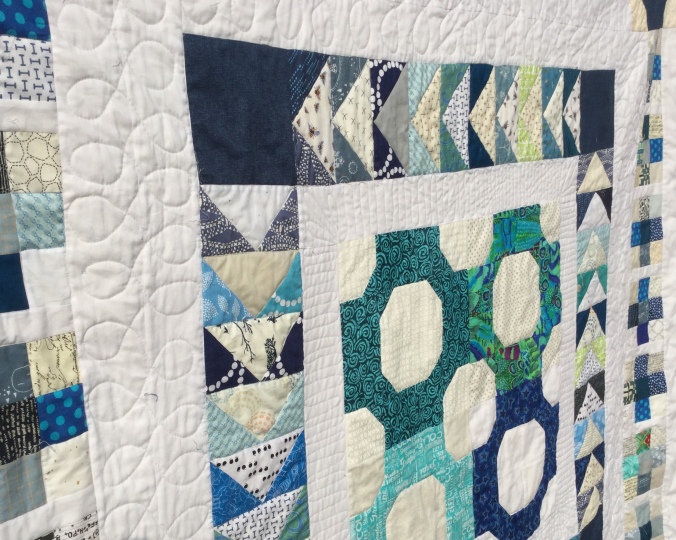






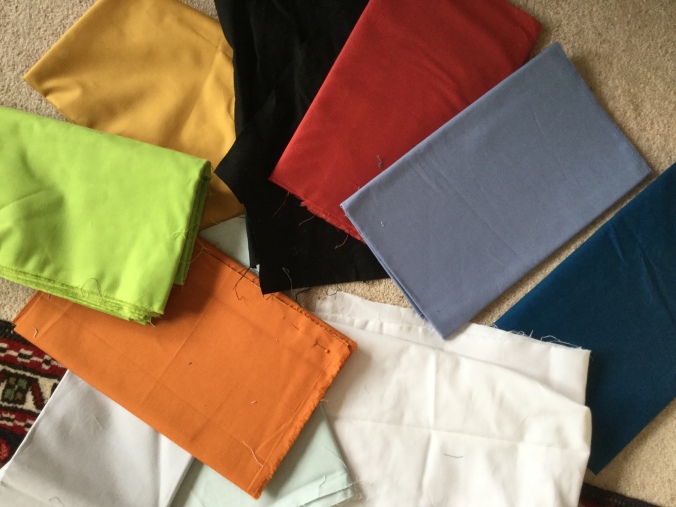












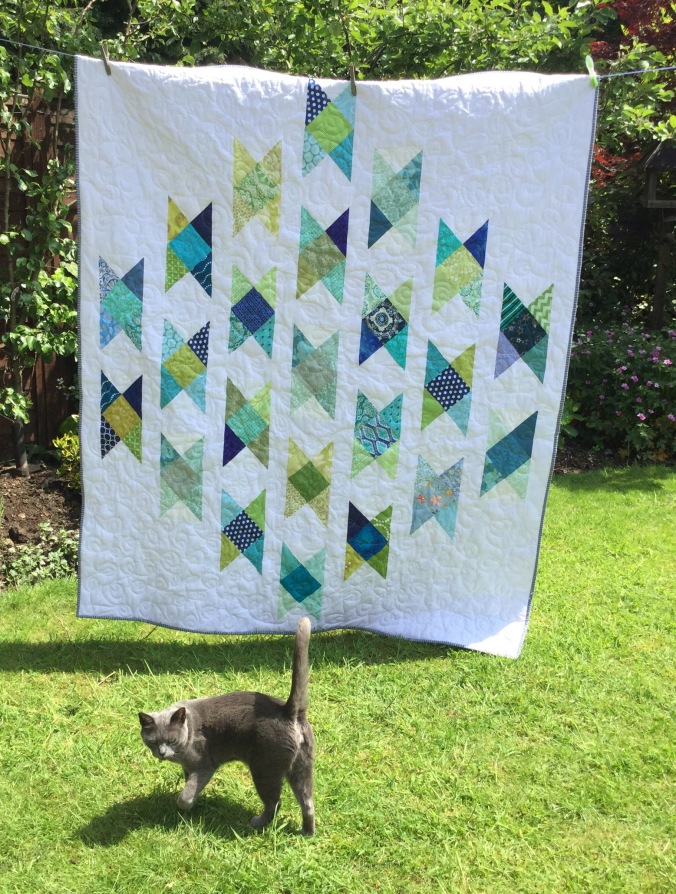


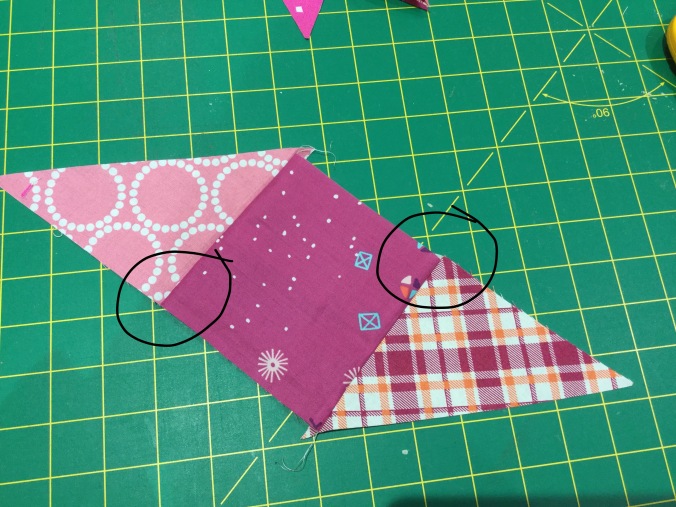


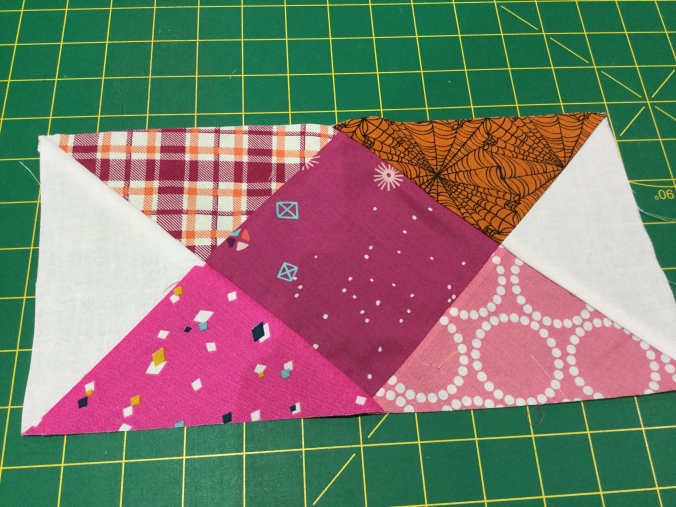 The finished blocks are a smidgeon over 6″ by 11 3/4″. But don’t worry too much – they will be sashed as you can see from the pattern.
The finished blocks are a smidgeon over 6″ by 11 3/4″. But don’t worry too much – they will be sashed as you can see from the pattern.